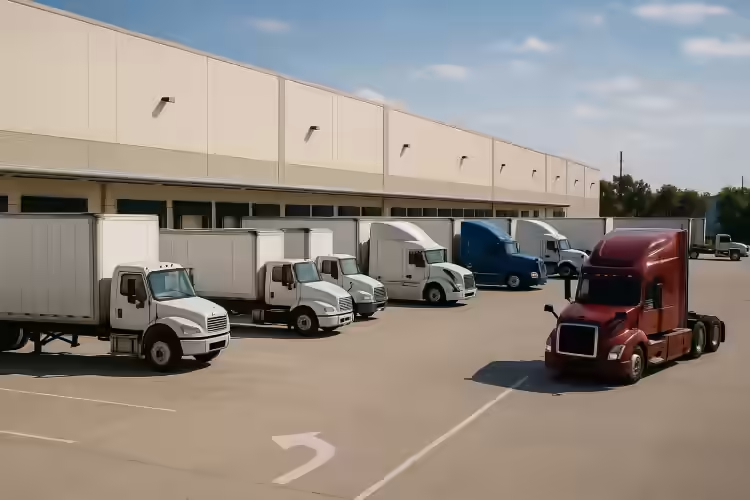Fleet Access Considerations for Warehouse Sites
Why Fleet Access Matters More Than You Think
Let’s say you find the perfect warehouse. Right size, great price, and zoned just right. But then your first 53’ trailer pulls in—and immediately gets stuck trying to turn around.
Oops.
Fleet access is one of the most underrated factors in choosing a warehouse site. And yet, for companies running trucks in and out all day, it can make or break operations.
Think about it: every extra minute a driver spends waiting to turn, dock, or exit the site costs you money. Add that up across dozens of deliveries a day, and suddenly what seemed like a good deal is bleeding your margins.
In other words, the way trucks access your site isn’t just a logistics issue—it’s a profitability issue.
Site Layout and Truck Flow
Let’s start with the basics: how trucks move on your site.
The most efficient warehouse sites are designed like a racetrack—one way in, one clear loop through, and one way out. Simple. Clean. No cross traffic between trucks and employees. No dead ends.
But some properties aren’t built with flow in mind. Especially older ones. You’ll see tight corners, blind spots, shared car/truck entrances, and delivery lanes that double as fire lanes. Yikes.
Ideally, your layout should support:
- Separate entrances for trucks and employees
- One-way loops for delivery traffic
- Dedicated staging lanes to keep dock areas clear
- Safe pedestrian zones, marked and protected
Turning Radius and Maneuverability
Trucks need room. A lot of it.
A standard 53’ trailer with a sleeper cab needs about 130 feet to make a full turn. That’s more than a third of a football field. And that’s assuming they’re not backing into a dock or dodging light poles.
But you’d be surprised how many industrial sites forget this in their design.
Look for the following when evaluating a site:
- Wide drive aisles: Minimum 40–50 feet between rows of loading docks is ideal.
- Large turning aprons: Especially at gate entries and near tight corners.
- Minimal obstructions: No random planters, poles, or curbs where a trailer needs to swing wide.
Ingress, Egress, and the Flow of Traffic
Getting in and out of the site isn’t just about what's inside the fence—it’s about the roads outside too.
A good warehouse needs easy access to arterials, highways, and interstates. If trucks have to snake through residential streets or wait 15 minutes at a left-turn light with no signal, that’s a red flag.
Also: is the site accessible 24/7?
Some industrial parks in Miami or Long Beach have gate restrictions, curfews, or local truck bans after a certain hour. That’s a big deal if your operations run late.
Checklist for smooth ingress/egress:
- Multiple entry/exit points for truck traffic
- Signalized intersections nearby (or dedicated left turn lanes)
- Room for queuing off the main road (you don’t want trucks blocking traffic)
Local Regulations and Road Restrictions
Welcome to the world of “truck-unfriendly” cities.
Many local governments have rules about where trucks can and can’t go. Sometimes it’s about protecting residential areas. Other times it’s due to weight limits, bridge clearances, or air quality initiatives.
Whatever the reason, these rules can impact your bottom line.
Examples:
- Seattle: Restricted bridge heights limit access for certain trailers.
- Chicago: Many urban corridors are “No Truck” routes unless you have a delivery permit.
- Newark: Enforced quiet zones mean trucks can't idle or back up during overnight hours.
Dock Design and Yard Depth
This one’s huge. Literally.
Your yard depth—the space between the building and the property line—needs to be deep enough to allow a full truck to back into a dock without spilling into drive aisles or neighboring lots.
Rule of thumb: a 120-foot truck court depth is considered good. 135–150 feet is better. Anything under 100 feet? Tough for modern logistics.
Also look at dock count and spacing:
- Are there enough doors for your volume?
- Are they levelers or pit-style docks?
- Do they support swing doors, roll-up, or both?
Parking, Staging, and Idling Areas
Ever had trucks show up early and nowhere to park? Or worse, block drive aisles while waiting?
That’s what happens when staging areas are an afterthought.
Look for:
- Dedicated trailer parking: Especially if you preload trailers or do drop-and-hook ops.
- Driver waiting zones: With restrooms or minimal facilities.
- Idling policies: Some cities fine for unnecessary idling, so build in room for efficient processing.
Final Thoughts
Fleet access isn’t just a checkbox. It’s a critical piece of operational strategy.
Too many businesses lease warehouse space that “works on paper,” only to find out it’s a nightmare once the trucks show up.
If your business depends on efficient truck movement, make fleet access a top priority. Walk the site. Drive the route. Sit in a semi and see how it feels.
Because a warehouse that fits your inventory but chokes your trucks? That’s not a win.
And the best part? Sites with good access don’t just run better—they attract better carriers, lower turnaround times, and make life easier for everyone on your ops team.
Now that’s a solid investment.

